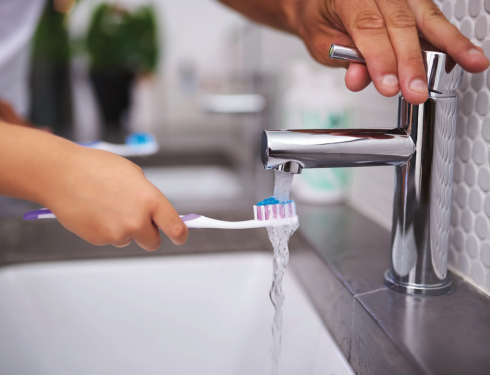Plaque is a sticky layer of bacteriacontaining film that accumulates on teeth, especially in places where toothbrushes can’t reach. Plaque is essentially the waste product left behind when these bacteria in our mouths consume the sugars in our daily diet. Once formed, plaque functions as a colony for the bacteria, allowing them to consume more. Many of the foods we eat cause the bacteria to produce acids, which break down tooth enamel and can cause cavities. In addition to sugary foods, starches — such as bread, pasta and potatoes — also can cause acids.

How does plaque affect my mouth?
Consistent plaque buildup can cause more problems than just cavities. Tartar (or calculus) is a calcified deposit that can form when plaque is not removed with thorough daily brushing.
Gingivitis occurs when tartar collects above the gum line and causes the tissue to swell and bleed easily. If not treated, gingivitis can develop into gum disease, when the gums start to pull away from the teeth.
How can I reduce plaque?
The best way to remove plaque is to brush your teeth for at least two minutes, twice per day. Brushing removes the plaque from tooth surfaces.
Some electric toothbrushes include timers to let you know how long to brush each surface of your teeth. Brush your tongue as well — this removes bacteria and freshens breath.
n addition to brushing, daily flossing is essential to remove plaque and help prevent tooth decay and gum disease. If you haven’t already, try to incorporate flossing into your daily routine — try it when you get dressed in the morning, when you prepare for bedtime or at any time in between
Also, schedule regular cleanings with your dentist to remove any plaque that might have built up.
How can my child maintain good oral hygiene?
Lead by example and practice good oral hygiene yourself! Teach your child about the importance of good oral hygiene and regular brushing. Start flossing between your child’s teeth as soon as he or she has two teeth that touch each other (after he or she is 1 year old). Your child should continue to floss as he or she grows older so that it becomes part of their oral hygiene routine.
Consistent plaque buildup can cause more problems than just cavities. Tartar (or calculus) is a calcified deposit that can form when plaque is not removed.
Take your child to the dentist regularly for cleanings and checkups. Getting your child’s teeth cleaned regularly can help prevent gum disease and remove tartar and plaque buildup. Your dentist also can examine your child’s entire mouth and detect issues early — before they become bigger, more painful problems. For more oral hygiene tips for you and your children, talk with your dentist.
© COPYRIGHT 2019 BY THE ACADEMY OF GENERAL DENTISTRY. ALL RIGHTS RESERVED.